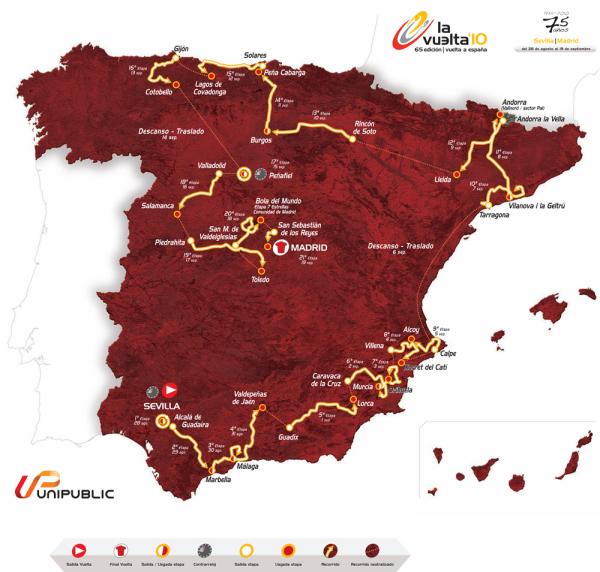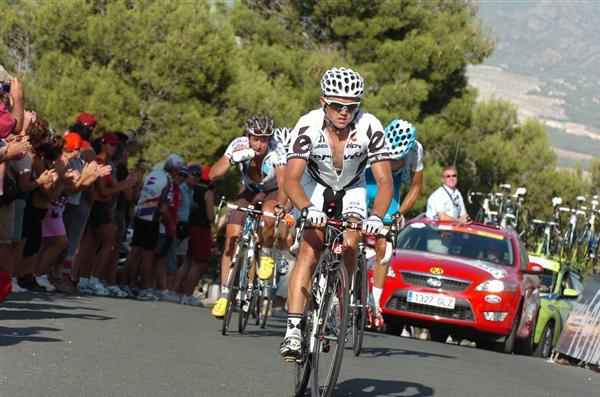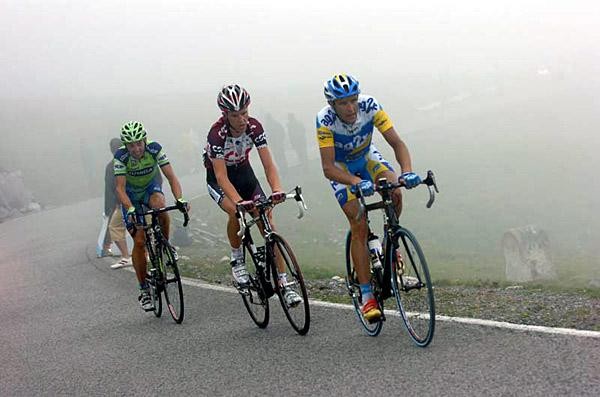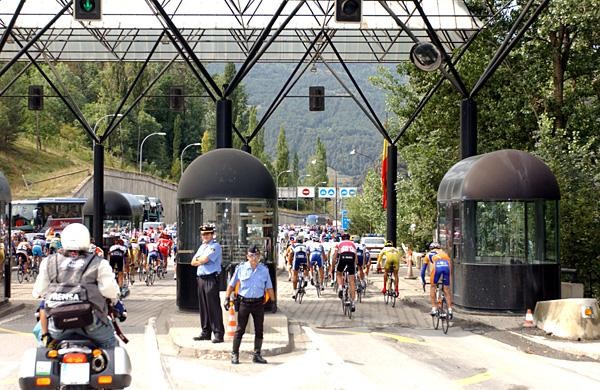Vuelta a España route analysis
An overview of the season's final grand tour




When the Vuelta a España route was unveiled last December, one of the first things observers noted was that it appeared to be the 2009 parcours run in reverse. While last season’s race wound clockwise around Spain, this year’s event travels in the opposite direction but tackles much of the same lumpy terrain inland from the country’s south and east coasts. And where last time around the tour began with pan-flat stages tailor-made for mass sprints, this year the fastmen will barely get a look in before the race’s final few days.
It’s a novel route, then, for a race desperate to reassert itself. While the Tour de France is the behemoth that dominates the calendar, the Giro d’Italia has also enjoyed something of a renaissance in recent years with some innovative route design and spectacular racing. Meanwhile, the Vuelta, trapped in the no-man’s land between the Tour and the world championships, has been floundering in search of an identity, as yet another change of colour to the leader’s jersey in 2010 suggests.
It’s against such a backdrop that the Vuelta organisers have come up with this year’s testing route. When the stages were being planned last autumn, there was no way of knowing precisely who would be on the start-line come this August. For different reasons, the participation of the last two winners, Alejandro Valverde and Alberto Contador was always in doubt, and so it has turned out. Meanwhile and as per usual, foreign stars were slow to commit to the race so far in advance.
Thus, while the old cliché may state that it’s the riders and not the route that makes the race, the Vuelta organisers were taking no chances when they mapped out their 3,400 kilometres around Spain.
A back-to-front race: sprints in the final week
Ever since the Vuelta first switched to an autumn start date in 1995, when Abraham Olano went straight from chasing Laurent Jalabert’s coattails in Spain to winning the rainbow jersey in Colombia, the race has become the warm-up event of choice for those with aspirations of winning the world championships. With this year’s Worlds touted to be set for a bunch sprint (although the closer the time comes, the less certain everybody is), it’s no surprise to find a plethora of top sprinters headed for the Vuelta.
It may be a surprise for them on arrival, however, to find that potential sprint finishes are thin on the ground at this year’s race, especially in the opening week. Unlike the Tour, which generally signs over the first seven days of the race to the sprinters before starting in earnest, there are just two stages before the first rest day that seem certain favour the sprinters, stage 5’s downhill run-in to Lorca and stage 7’s blow-out to Orihuela, but even the latter has a nasty hill thrown in just before the finish that might just derail the sprinters’ trains.
Get The Leadout Newsletter
The latest race content, interviews, features, reviews and expert buying guides, direct to your inbox!
Stage 12 brings the race down from the Pyrenees and on paper could well turn out a sprint, if the teams have the motivation, but after that, the fast men have to wait until the race’s closing days for some more exposure. On the last Thursday, the race visits Salamanca, where Mario Cipollini suffered his horrific crash in the finishing straight at the 1994 Vuelta, while the final day’s promenade in Madrid will suit any sprinter that hasn’t already packed his bags for Melbourne two weeks into the race.
In short, Cavendish, Farrar, Freire et al may well come to the Vuelta to prepare for the Worlds, but they shouldn’t expect to be padding out their palmares too much on what appears a difficult to control route.
Just one individual time trial
The traditional stereotype of the Spanish rider used to be of a climber who didn’t like to time trial. Ever since the days of Miguel Indurain, an ever-increasing number of home riders are more than adept against the watch, but nonetheless this year’s Vuelta sees a meagre 59km of time trialling. 13 of these come in the opening night team timetrial around Seville, while the mechanics don’t have to dust off the low-profile machines again until the final week, with an out and back strongman’s course at Peñafiel. A bad showing here might just be enough to lose someone the Vuelta, but if he wants to win it, he’ll have to know how to climb….
A lumpy start
Aside from the five potential bunch sprints and two time trials mentioned above, virtually every other stage of the race offers the overall contenders the chance to ambush one another, as the Vuelta organisers liberally pepper their route with tricky climbs and rolling roads. Where the Giro has in recent years opted to find the toughest mountain stages imaginable, the Vuelta has abandoned that practise to an extent, as demonstrated by this year’s course. Instead of set-piece mountains like the Angliru, the race is crammed full of shorter and less steep climbs designed to blow the race apart on an almost daily basis.
The first week is especially daunting in this regard. Stage 2 to Marbella offers a taster, with two category three climbs that should see a breakaway deny the sprinters glory. The next day to Malaga is already the first major rendezvous for the overall contenders, with the race tackling the 1st category Puerto del Leon (15.8km at 5.4%). Just to ensure that an overall contender will be wearing the red jersey that night, the stage finishes atop a sharp 1.8km climb to Castillo de Gibralfaro, not unlike the finish in Mende at this year’s Tour de France, where Alberto Contador went on the attack.
The race continues in a similar vein for the remainder of week one. There’s a rugged day to Valdepeñas de Jaén that could prove difficult for the red jersey to control, while stage 6 to Murcia features the Cresta del Gallo (7km at 4.4%) climb in the finale. With just a 10km drop from the summit to the finish, it could wreak havoc on the race.
Not surprisingly, the second weekend of the race sees a pair of made-for-TV stages. First up comes the fearsome Xorret del Catí climb at the finish of stage 8. Just 3.8km in length, it qualifies as a 1st category climb because it pitches up at a leg-snapping 11.5%. Coming at the end of a long day over rolling terrain, it could be a big moment in the race for the red jersey. The next day sees no fewer than six climbs, and while there are no 1st category mountains on the road to Alcoy, it’s sure to see the race break up once again, just ahead of the first rest day.
What impact these climbs will ultimately have on the overall situation is open to debate. It is worth noting, however, that for a past winner of Liege-Bastogne-Liege, Andy Schleck was surprisingly vulnerable on short steep climbs at the Tour, where his lack of punch was exposed. Home riders who want to disrupt the Schleck brothers’ Spanish campaign could do worse than look to put the cat amongst the pigeons during the first week.
The big mountains
Between the two rest days come the major difficulties of the 2010 Vuelta. First up are the Pyrenees, with the long climb to the Andorran ski-resort of Pal on stage 11. While technically, the climb is just 9.9km long at 6.5%, in reality the riders will face a lengthy run-in on a steadily-rising false flat that will sting the legs before the road pitches skywards in earnest. A rider like Carlos Sastre, who often suffers on the earlier slopes of the big passes before recovering nearer the summit, could well benefit from the gentle introduction to proceedings here.
Worse is then to follow for those who don’t bring their climbing legs to the Vuelta. Straight after an undulating day to Burgos where the wind might well be conducive to echelons, stage 14 is the first of three consecutive days in the mountains of Cantabria and Asturias. After the climbs of the Bocos, Lunada and Caracol, the stage finishes atop the Peña Cabarga. It may be just 6km long, but its 9.2% slopes will blow the race open once again.
Next comes a summit finish at the legendary Lagos de Covadonga, and as befits the Vuelta’s answer to the Alpe d’Huez, the organisers have given it pride of place by making it the only climb on the stage. All day long the peloton will have this mountain in mind, and the 12.5km climb at 7% is one of the toughest tests at this year’s race. We can expect dramatic scenes on the agonising 13% stretch at La Huesera in particular.
The following day is the last of this trio of mountain stages and arguably the toughest. After easing their way in with the 3rd category Cabruñana, the peloton faces the 1st category climbs of Puerto de San Lorenzo (10km at 8.5%) and Alto de la Cobertoria (8.1km at 8.5%) before a first-time summit finish at the Alto de Cotobello (10km at 8.2%). Climbers at the Tour de France often bemoan the fact that there are rarely more than two consecutive mountain stages, which makes it difficult to crack the rouleurs. They can have no such complaints at the Vuelta. If Denis Menchov wants to take home a third Vuelta title, he’s going to have to hang tough here.
A sting in the tail
After the late time trial, there is one final opportunity for a shake up of the general classification on the race’s last weekend. The penultimate stage of the race in the Sierra de Guadarrama outside Madrid will offer a potentially race-deciding showdown. The climbs of the Alto del León (7.8km at 6.9%) and the Puerto de Navacerrada (7km at 7.5%) are the appetisers before the summit finish at the new climb of the Bola del Mundo.
This last climb is in fact the southern face of the Navacerrada with an extra 3km ramp up to Bola del Mundo tacked on for good measure. This last section includes a 23% slope that will bring the race almost to a standstill, with the red jersey to be decided at the summit. Overall, with 21.6km of climbing at an average gradient of 6.3%, it could just be the kind of mountain that suits a rider who can set a relentless tempo to burn off his rivals rather than a climber blessed with a quickfire acceleration. If one or both of the Schleck brothers are still in contention here, expect fireworks.
Consistency the key
When the route was presented last December, it appeared on first glance a Vuelta solely for the climbers, as the limited time trial miles and the succession of summit finishes in the second week leapt off the page. In reality, the race is a little more evenly balanced than that.
Certainly, it’s a given that the overall winner will have to be able to get over the high mountains and to respond to attacks on the shorter, steeper climbs that are sprinkled across the three weeks. Out of that select group of riders, however, the red jersey wearer in Madrid will be the one who best retains his focus over the three weeks of racing. With potentially decisive stages coming so early in the race, hitting the ground running and staying consistent thereafter is essential.
Route statistics
Total distance: 3400km
Time trial kilometres: 59km
High mountain stages: 8
Summit finishes: 6
1st category climbs: 12
Total categorised climbs: 44
Most climbs in a day: 7 (Stage 9, Calpe-Alcoy)
Rest days: 2
Longest stage: 208km (Stage 11, Vilanova i la Geltrú-Andorra)
Shortest road stage: 100km (Stage 21, San Sebastián de los Reyes-Madrid)

Barry Ryan was Head of Features at Cyclingnews. He has covered professional cycling since 2010, reporting from the Tour de France, Giro d’Italia and events from Argentina to Japan. His writing has appeared in The Independent, Procycling and Cycling Plus. He is the author of The Ascent: Sean Kelly, Stephen Roche and the Rise of Irish Cycling’s Golden Generation, published by Gill Books.